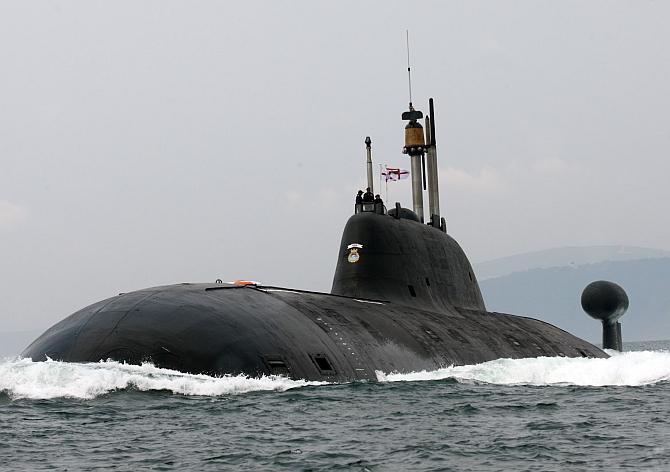Building 6 conventional submarines is one of the Indian Navy's most important weapon construction programmes.
Ajai Shukla reports.

Kickstarting one of the Indian Navy's most important weapon construction programmes, the ministry of defence issued a tender for building six conventional submarines, at an Indian shipyard, in technology partnership with a chosen global original equipment manufacturer (OEM).
The MoD has pegged the cost of six submarines at about Rs 43,000 crore (Rs 430 billion) This means that each boat (navies traditionally refer to submarines as 'boats') will cost a staggering $1 billion.
This six-submarine acquisition, code-named Project 75(I), follows on from the ongoing Project 75 -- the construction of six conventional Scorpene boats by Mazagon Dock Shipbuilders, with technology supplied by Naval Group of France.
Three of the six Scorpenes have already joined the navy's fleet. The remaining three are expected to join by 2023.
'Project 75(I) envisages indigenous construction of six modern conventional submarines... with contemporary equipment, weapons, and sensors, including fuel cell-based air independent propulsion plant, advanced torpedoes, modern missiles and state-of-the-art countermeasure systems,' the MoD stated.
Project 75(I) will be the first acquisition programme under the MoD's strategic partnership model. That involves selecting an Indian firm as the strategic partner to oversee and control the project. Two SPs have been shortlisted already: Mazagon Dock and Larsen & Toubro.
The shortlisted strategic partners are required to submit proposals for building the six submarines in partnership with any of five foreign OEMs the MoD has shortlisted.
The shortlist is: Naval Group from France; ThyssenKrupp Marine Systems from Germany; Russian export agency Rosoboronexport; Daewoo Shipbuilding & Marine Engineering Co. from South Korea; and Spanish shipyard, Navantia.
'These five foreign firms are the world leaders in the field of conventional submarine design, construction, and all other related technologies. Foreign OEMs will enable SP for construction of submarines, achieving high levels of indigenisation, and transfer of technology (ToT),' the MoD stated.
'These OEMs would enable setting up of dedicated manufacturing lines for these submarines in India by providing ToT for submarine design and other technologies and make India the global hub for submarine design and production,' the MoD added.
The most complex technological challenge in Project 75(I) is the integration of the air independent propulsion plant systems into the six submarines. An air independent propulsion plant system increases the boat's underwater endurance and therefore, its survivability.
Diesel-electric submarines, such as India's Kilo-class and Scorpenes, are powered by enormous banks of electric batteries, which drive electric motors that turn the submarine's propellers.
Since batteries get discharged quickly, the submarine must surface every day or two to recharge them by running diesel generators (which require atmospheric air). However, surfaced submarines are visible to radar and, therefore, vulnerable to attack.
Nuclear boats bypass this vulnerability, since they can remain submerged almost indefinitely. However, designing a small nuclear reactor poses major technology challenges. The Navy is processing a Rs 90,000 crore (Rs 900 billion) project to build six 6,000 tonne, nuclear-powered, attack submarines. However, that could be a decade in the making.
Until these nuclear boats are commissioned, the air independent propulsion plant provides an interim solution. Since they do not have conventional batteries that require generator charging, boats with air independent propulsion plants can remain submerged for 10-14 days, reducing vulnerability.
The air independent propulsion plant fuel cell technology that the MoD has specified generates power through the reverse electrolysis of oxygen and hydrogen, which are carried on board the submarine. This charges the submarine's batteries, doing away with the need for a diesel generator.
Citing the stated aims of the standard partner model, the MoD said: 'Project 75(I) would not only aid in boosting (India's) core submarine/shipbuilding industry, but would also greatly enhance manufacturing/industrial sector, especially the micro, small and medium enterprises by development of an industrial ecosystem for manufacture of associated spares/systems/equipment related to submarines.'
'In order to achieve these objectives, the request for proposal has key features like mandatory level of indigenous manufacture of platforms, ToT for design/manufacture/maintenance of submarines and a few critical equipment and systems, setting up of an ecosystem in India for such indigenisation and incentivisation for other key technologies, etc,' the MoD said.
'The overall aim would be to progressively build indigenous capabilities in the public/private sector to design, develop, and manufacture complex weapon systems for the future needs of the armed forces,' the MoD added.
The standard partner model, which is detailed in the Defence Acquisition Policy of 2020, is intended to provide a leading role to private Indian firms in building four categories of defence equipment: Submarines, fighter aircraft, helicopters, and armoured vehicles.
However, there is resentment among private shipyards at the inclusion of defence public sector firm, Mazagaon Dock, in the shortlist for Project 75(I).












